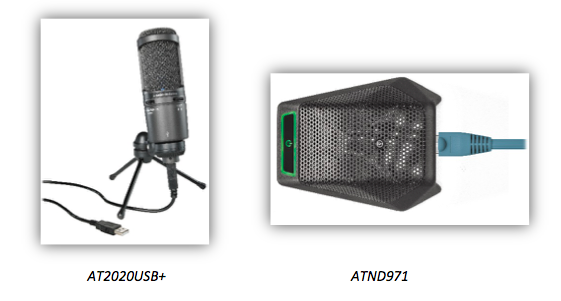Question: What is computer bus power, plug-in power, and PoE?
Answer: As a continuation of the past two weeks’ blog posts on power used to operate microphones, we’ll now examine computer bus power, plug-in power, and PoE, which are provided primarily by computers and computer network switches. Like phantom power and bias voltage, these types of power are used to drive certain microphone elements and/or the digital components contained within them.
Audio-Technica USB microphones operate on computer bus power. Similar to when you plug in an external hard drive to your computer, the digital components of the USB microphones need to be powered, and the voltage provided from the computer’s USB port is utilized, eliminating the need for other external power sources. USB, short for Universal Serial Bus, provides roughly up to 5 volts of power to the external device. Microphones like the Audio-Technica AT2020USB+ use this voltage to power the impedance-matching transistor (preamp), digitize the captured audio, and power an internal headphone amplifier. The AT2005USB has a dynamic microphone element and does not require any voltage for the microphone to operate, but the bus power is used to drive the digital conversion electronics and internal headphone amplifier. This design allows the microphone element to be used digitally via USB connection to the computer, or be used in a conventional manner via a standard XLR analog connection to a microphone input on a mixer or console. USB power limits the length of cable that can be used, as the power degrades with distance. If enough power is lost, the USB devices, including USB microphones, will no longer operate properly.
 Plug-in power (aka “PiP”) is similar to USB power but is often found in “prosumer” 3.5 mm microphone inputs to computer soundcards, video camcorders, field recorders and the like. Small microphone elements, such as that found on the ATR4750, only require a small amount of voltage to operate, and the minimal 3–5 volts from the plug-in power will sufficiently drive the microphone. PiP is also different from phantom power as it can travel over an unbalanced audio line via the signal conductor and return through the sleeve. As always, check with the specific manufacturer specs to verify that the recording device provides PiP.
Plug-in power (aka “PiP”) is similar to USB power but is often found in “prosumer” 3.5 mm microphone inputs to computer soundcards, video camcorders, field recorders and the like. Small microphone elements, such as that found on the ATR4750, only require a small amount of voltage to operate, and the minimal 3–5 volts from the plug-in power will sufficiently drive the microphone. PiP is also different from phantom power as it can travel over an unbalanced audio line via the signal conductor and return through the sleeve. As always, check with the specific manufacturer specs to verify that the recording device provides PiP.
Network audio also provides a power solution for condenser microphones called Power Over Ethernet, or PoE. Specific network switches will feature PoE, which may provide up to 25.5 watts of power carried over CAT5 (or better) twisted pair cable. Microphones with a Dante™ output, such as the ATND971, use PoE with a power consumption of just 1.5 watts. Along with the large amount of current that PoE can carry, the distance also far exceeds the previously listed computer power options. CAT5 (or better) cable can be run 100 m (320 feet) with no signal or power loss. This is another reason network audio, along with other network solutions, is becoming very popular. IP cameras, wireless access points, and network phones all often use this power technology. Network audio is quickly being implemented into installed audio systems, recording studios, and live performance spaces due to its power solution, the lightweight cable design of CAT5 (or better) cable, and networking possibilities. Many audio manufacturers are implementing Dante network technology into their products.
Audio technology has changed over the years and power for that technology has changed with it. By utilizing phantom power, bias voltage, or one of the various forms of computer power solutions, Audio-Technica makes certain you will be able to use your favorite Audio-Technica products with a variety of devices. If you have any questions about audio powering solutions, feel free to contact our Audio Solutions Department.